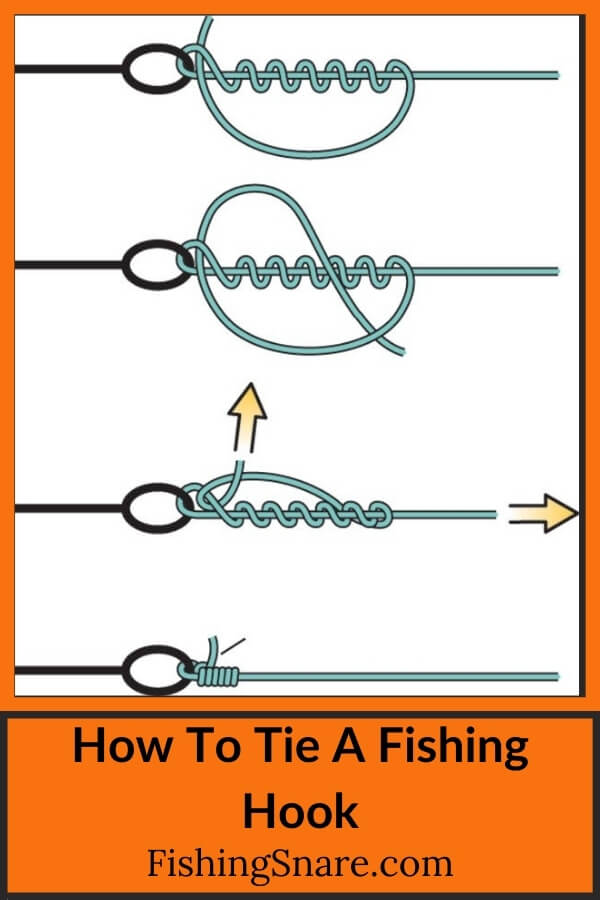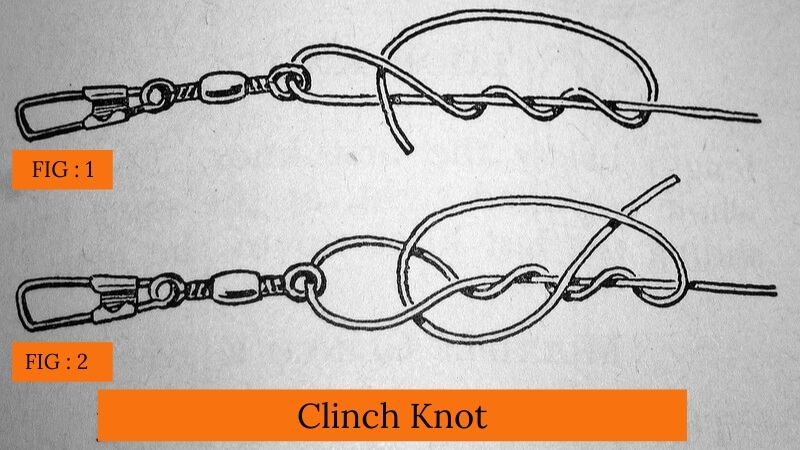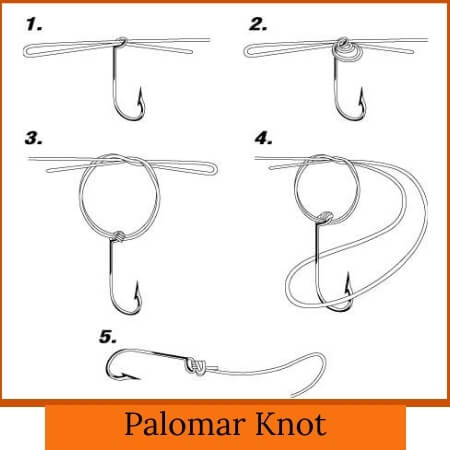Fishing can turn into a disaster if the fishing hook is not secured properly with the line and reel. So, to make sure such a disaster does not happen, you need to know how to tie a fishing hook properly.
A fishing hook can come loose quickly if the knot around it is not perfectly done. And to perfect tie the hook, you need to know how to tie a fishing hook knot.

Fishing Knots:
There are a few knots that are commonly used by anglers. To learn how to tie a fishing hook, one also needs to learn the techniques of tying fishing knots. If you are a beginner, these instructions are for you too.
Popular Knots:
There are many popular knots for tying a fishing hook, and it can be difficult to know which one to use. we’ll discuss some of the most popular knots and help you choose the right one for your needs.
One popular knot is the Palomar knot. This knot is easy to tie and provides good strength and stability. It’s a good choice for those who are new to fishing or don’t have a lot of experience with tying knots.
Another popular option is the Uni Knot. This knot is slightly more complex than the Palomar knot, but it provides better strength and security. It’s a good choice for experienced fishermen who want a reliable knot.
Finally, the Clinch Knot is a popular choice for those who want a strong and secure knot. It’s more complex than the other two knots, but it’s worth the extra effort for its strength and reliability.
Here’s a list of some common knots:
- Clinch Knot
- Palomar Knot
- Loop Knot
- Spade-End Knot
- Uni Knot
- Blood Knot
- DOUBLE SURGEON’S LOOP
There are many different types of fishing line knots, No matter which knot you choose, be sure to practice tying it before you go out on the water. This will ensure that you can tie it quickly and easily when you need to.
Clinch Knot:
If you want to learn how to tie a fishing knot easily, then the Clinch knot is the best one to start with. It is the most popular, effective, and easiest way to tie a fishing knot.

Here’s how to tie the Clinch Knot:
- Slip the fishing line through the hole of the hook. Make sure you pull a few inches of the line through the hook.
- Wrap the tag end a few times around the line.
- Then thread the tag end through the loop closest to the hole of the hook.
- And pull both lines together so that the knot tightens properly around the eye.
- Trim the loose end of the line, if needed.
Palomar Knot:
Many anglers believe that the Palomar knot is the strongest of fishing knots. It is also as easy as the Clinch knot. But the perk of a Palomar knot is that, if needed, you can tie this knot in the dark or even with your eyes closed.

Here’s how to tie Palomar Knot:
- Double the fishing line.
- Thread the loop through the hole of the hook.
- Then tie an overhand knot.
- Tread the loop carefully through the fishing hook.
- Gently pull lines to tighten the knot.
- Trim the loose end, if needed.
Loop Knot:
If you are learning how to tie a fishing lure, then the loop knot is very effective. So are the knots mentioned above.
A loop knot helps the lure to move freely in the water. Thus, it looks more realistic, and it attracts big fish.
Here’s how to tie Loop Knot:
- Tie an overhand knot, leaving a few inches of the free tagline.
- Slip the end line through the hole of the lure.
- Retake the tag end and slip it through the overhand knot.
- Wrap the end 3 to 5 times around the overhand line.
- Pull the end back to the overhand knot and pass it through the knot.
- Pull the ends until it is knotted tightly.
- Trim the loose end, if needed.
Spade-End Knot:
Tying the knot around the hook with a hole might sound easy. But what will you do if the hook has no hole?
This is why you need to learn how to tie a fishing hook without a hole. And to do that, you will need to learn about the spade-end knot.
This knot is a little tricky. But it is also as strong as the other ones.
Here’s how to tie the Spade-End Knot:
- Lay the line under the hook and form a loop.
- Pinch the lines together using your fingers.
- Take the tagline and wrap it a few times around the shank of the hook.
- Pass the tag end through the loop behind the hook.
- Pull both ends firmly.
- Trim the loose end, if needed.
Uni Knot:
The Uni Knot is particularly well-suited for tying monofilament lines, as it provides a strong connection while still being able to slide through the guides on your rod.
While it may take a few practice tries to master the Uni Knot, it is well worth the effort. Once you’ve learned how to tie it, you’ll find that it is an extremely useful knot to have in your repertoire.
Here’s how to tie the Uni Knot:
1. Start by threading the line through the eye of the hook or lure.
2. Next, double back and make 5-7 wraps around the standing line. Be sure to leave enough space between the wraps so that they can slide easily.
3. Now thread the end of the line through the loop that you’ve created.
4. Moisten the wraps with water or saliva, and then pull on both ends of the line to tighten everything down. Trim away any excess line.
Blood Knot:
Blood Knot is an essential skill for any angler. Not only does it allow you to join two pieces of line together, but it also creates a strong connection that won’t slip or come undone.
While there are many different ways to tie a Blood Knot, the following steps will provide a basic overview of how to tie this essential knot.
Here’s how to tie the Blood Knot:
1. Begin by holding the two pieces of line together in your left hand, with about six inches of overlap.
2. Next, use your right hand to make five wraps around the standing line, starting from behind and ending in front.
3. Then, thread the end of the line through the loop that you’ve created.
4. Finally, wet the knot and pull it tight. You may need to use pliers to get a tight seal.
By following these simple steps, you can easily tie a Blood Knot that will hold fast under any conditions.
DOUBLE SURGEON’S LOOP:
A double surgeon’s loop is a type of loop knot that is commonly used by fishermen and boaters. It is a strong and versatile knot that can be used for a variety of purposes, including attaching hooks, lures, and lines to leaders. While it may look complicated, the knot is actually quite easy to tie.
Here’s how to tie the DOUBLE SURGEON’S LOOP:
1. Begin by threading the line through the eye of the hook or lure.
2. Next, make a small loop in the line, holding it between your thumb and forefinger.
3. Wrap the working end of the line around the standing part of the line 5-6 times.
4. Pass the working end through the small loop you created in step 2, then through the large loop that has been formed around the standing part of the line.
5. Moisten the knot and pull it tight. You’ve now tied a double surgeon’s loop.
Hook and Weight:
If you want to learn how to tie a fishing hook and weight, you are already halfway there. The best way is to tie the weight at least 6 to 12 inches above the hook.
In this way, it helps the hook to sink more and move properly.
How to:
- Take a long line and pass the tagline through the eye or hole of the weight.
- Keep a few inches of tagline on the loose to tie the hook later.
- Take the tag end line and wrap it a few times around the standing line.
- Pull the tag end line and slip it through the loop closest to the eye.
- Gently pull them to secure the line around the weight.
Hook and Swivel:
A swivel helps the fishing line from getting twisted. It is a metal device with rotating rings at both ends.
If you want to know how to tie a fishing hook to a swivel, we have got you covered. You can use any of the Clinch, Palomar, or Loop knots to tie a fishing hook or hook line to a swivel.
Endnote:
There are many ways to tie a fishing knot. One is different from the other one both in technique and purpose. We tried to help you out with some of the easiest ways.
But remember to research before you attempt something. And make sure you know your gadgets and gears inside out.
Also, remember that anything can get a little tricky in the beginning. But be patient and follow the instructions, and you will learn how to tie a fishing hook in no time.
Hi, my name is Luis Leal and I am a professional angler. Fishing is my hobby and I love to share my fishing experiences with others. I have been fishing for the last six years and in that time, I have learned a lot about this fascinating sport. In addition to fishing, I also enjoy sharing tips and tricks with other fishermen. It is my hope that through this blog, I can help others learn more about fishing and how to enjoy it safely and responsibly.